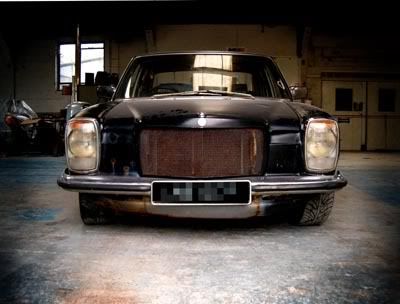Rob M
Posted a lot
  
Posts: 1,915
Club RR Member Number: 41
|
|
Sept 10, 2011 14:28:50 GMT
|
Its possibly been covered before, in a roundabout way, but is there anybody here who could give me the basics of getting a gearbox from one model to fit the engine of another? Leaving to one side whether a gearbox would stand up to the abuse an engine could give it, what things need to be taken into account when looking at a gearbox that you want to fit to an engine that, for example, may originally be of transverse fitting? Example: Lots of talk on various forums about the difficulties of fitting the "Duratec" engine longitudinally into a car due to finding suitable RWD gearboxes that would fit ( Jag V6 excepted) and, obviously, some people have done it by buying geaboxes that have been fitted in RWD configuration to its generic cousin. My question is "Is there no way that, say, a 2.8V6 Ford box could not be adapted to fit? Granted, the bellhousing is an issue but, what about flywheels, pressure plates, starter motors, clutch forks etc, etc. Assuming the bellhousing could be fabricated to bring the engine and box together, what else is going to be the major ball ache? Sorry for the long winded post, I'm very curious and the answers may help the seed in my head grow...  PS: I can figure out the semantics, i need somebody who may be able to flesh that out with experience and grazed knuckles or someone who can give me an idiots guide to the actual mechanics of how it "needs to work". Thanks! |
| |
|
|
|
|
|
|
|
Sept 10, 2011 14:54:08 GMT
|
|
That's weird, I was going to post a similar question yesterday but I couldn't seem to word it properly so I left it!
The thing that set my mind thinking about this was particularly spigot bearings, and where the input shaft would sit in relation to the engine with an "unnatural" union of engine of 'box.
If all goes to plan I'll be having these sorts of headaches in the coming days... ;D
|
| |
|
|
|
|
|
Sept 10, 2011 15:54:28 GMT
|
|
Almost anything can be done given the time and money to do it.
If it hasn't been done before there's probably a good reason for it though saying that there's very little that hasn't been done before.
I have a type 9 mounted to a 1275 A series, 50's technology mated to 80's technology from two very different cars and companies yet they fit with only one custom part (bell housing) and a few parts bin components.
Spigot bearings and bushes can usually be made and clutches are quite often just a hybrid to get the input shaft spline mated with a matching pressure plate.
It gets expensive having to buy parts that either don't fit or you find you only need part of a kit.
I think you'd need to post specifics of make model etc to get any real answer, but by far the most expensive and difficult part is the bell housing.
|
| |
|
|
sowen
Club Retro Rides Member
Posts: 2,245
Club RR Member Number: 24
|
|
Sept 10, 2011 19:25:29 GMT
|
A lot of it varies as to how the engine and gearbox are attached in their native environments. In my series Land Rover I have a cast aluminium adapter ring about 2" thick that bolts to the rear of the v8 engine block and encloses the flywheel which then attaches to a standard series gearbox at the correct depth for the standard clutch to work. The spigot is way to big on the gearbox to fit the v8 crankshaft, so either the crankshaft needs to be machined out to fit the standard series spigot bush, or the very end of the crank that protudes from the flywheel needs to be cut off and a plate bolts over the end of the flywheel bolts with the spigot bush inside. On my Rover p6, to get a later 5 speed gearbox to fit, I cannibalised the original 4 speed gearbox for the bellhousing, filed the back face flat and made a 10mm steel adapter plate which bolted with countersunk bolts to the front of my gearbox and the 4 speed bellhousing bolted to that so I could use the standard clutch mechanism. I did a lot of research and found that MGB's had the same input shaft splines as my new gearbox and were the correct 9" diameter to fit. I went to a local bearing supplier and bought a small needle roller bearing of the correct dimensions and type and pressed that into the spigot bush on the engine.   Alternatively on that engine, I could have used a bellhousing that would have fitted over the flywheel of the correct length, and made a new engine block to gearbox bellhousing adapter plate to fit as the engine has a steel plate bolted between the block and flywheel. At the time I didn't have a big enough piece of steel so the smaller adapter was made. |
| |
|
|
Rob M
Posted a lot
  
Posts: 1,915
Club RR Member Number: 41
|
|
Sept 11, 2011 8:37:33 GMT
|
|
Excellent stuff, thanks!
The pics help enormously!!
Putting my thicky head on, lets say you have a gearbox, fly wheel, clutch etc from one model. Is it feasable to get that flywheel to fit the donor engine end? Ive seen flywheels redrilled and, i assume, the semantics of doing it would be similar to redrilling car wheels? In theory IF the whole transmission side is taken lock stock and barrell to the donor engine, would it be then a case of fabricating a bellhousing to brring the two together and ensure there is somewhere for the starter ( I assume it would be from the engine the box came from) to be bolted to? If we look at the bellhousing as, basically, something that brings engine and box together then acts like a giant dust cover, would that way of thinking take you any further forwards?
|
| |
|
|
MrSpeedy
East Midlands
www.vintagediesels.co.uk
Posts: 4,791 
|
|
Sept 11, 2011 9:39:42 GMT
|
|
If it's any help, there's quite a lot of info and pics in my build thread from when I fitted a type9 in my Triumph. Link in my sig ;-)
|
| |
|
|
Rob M
Posted a lot
  
Posts: 1,915
Club RR Member Number: 41
|
|
Sept 11, 2011 11:33:50 GMT
|
If it's any help, there's quite a lot of info and pics in my build thread from when I fitted a type9 in my Triumph. Link in my sig ;-) Cheers fella, all info greatly appreciated! |
| |
|
|
|
|
|
Sept 14, 2011 11:30:40 GMT
|
By far, the easiest way to sort the clutch out, is to fit the engine with its standard flywheel, and clutch pressure plate. Then have a peek through an online Quinton Hazell catalogue, to find a clutch plate the same diameter, but with the correct amount of splines for the new gearbox Why do lots of expensive machining, if there's something available that just bolts-up, and it's nice and cheap  |
| |

You're like a crazy backyard genius! |
|
|
|
|
Sept 14, 2011 17:56:53 GMT
|
Anything will fit to anything. The challange is to do it for as little cost as possible whilst arriving at a solution which is durable and of the correct specification for the planned use. I think the only way to help in this case is to know exactaly what you can get for free, what you've already got and what you're trying to do. If you can answer those questions and maybe chuck in a couple of pics then you're onto the home straight. The next thing to do, assuming all goes well with above, is to get the engine out on the bench and line it up with the gearbox and see how well it fits. I've done a lot of this recently and is by far the best way to do it. It busts a lot of bullsh1p. At the pub people will tell you all kinds of things about what will bolt to what. Until you try it for yourself there aren't many other ways of finding out the truth. Examples. 2.3 long-throw crankshaft mounted in a 2.0 block. The online consensus was that the webbs would hit inside of the gearbox. Truth is they clear by miles. Worst thing is that the webbs hit the bottom of the pistons and the con-rods hit the bottoms of they cylinders. You have to grind a bit off the end webb as well as it catches.  Online rumour: Inlet manifold from an 80s Saab has to be swapped if upgrading to the 2000s cylinder head. Truth is, the old manifold bolts to the new cylinder head almost perfectly. I'll use a 2mm aluminum plate cut with a dremmel to cover up the small injector port holes on the side of the cylinder head.  So it pays to suck it and see. Try and bolt the two bits together and see where the gaps are. All the engines I've ever seen work on the same principle of using the flywheel to drive a clutch which is connected to a splined shaft comming out of the gearbox. |
| |
|
|
|
|
|
Sept 14, 2011 21:43:50 GMT
|
|
|
| |
1967 Triumph Vitesse convertible (old friend)
1996 Audi A6 2.5 TDI Avant (still durability testing)
1972 GT6 Mk3 (Restored after loong rest & getting the hang of being a car again)
|
|















